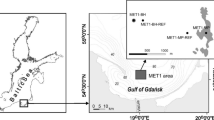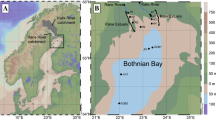Abstract
The Salton Sea is a large, saline, closed-basin lake in southern California. The Sea receives agricultural runoff and, to a lesser extent, municipal wastewater that is high in nutrients, salt, and suspended solids. High sulfate concentrations (4× higher than that of the ocean), coupled with warm temperatures and low-redox potentials present during much of the year, result in extensive sulfate reduction and hydrogen sulfide production. Hydrogen sulfide formation may have a dramatic effect on the iron (Fe) geochemistry in the Sea. We hypothesized that the Fe(II)-sulfide minerals should dominate the iron mineralogy of the sediments, and plans to increase hypolimnetic aeration would increase the amount of Fe(III)-oxides, which are strong adsorbers of phosphate. Sequential chemical extractions were used to differentiate iron mineralogy in the lake sediments and suspended solids from the tributary rivers. Iron in the river-borne suspended solids was mainly associated with structural iron within silicate clays (70%) and ferric oxides (30%). The iron in the bottom sediments of the lake was associated with silicate minerals (71% of the total iron in the sediments), framboidal pyrite (10%), greigite (11%), and amorphous FeS (5%). The ferric oxide fraction was <4% of the total iron in these anaerobic sediments. The morphological characteristics of the framboidal pyrite as determined using SEM suggest that it formed within the water column and experiences some changes in local redox conditions, probably associated with alternating summer anoxia and the well-mixed and generally well-aerated conditions found during the winter. The prevalence of Fe(II)-sulfide minerals in the sediments and the lack of Fe(III)-oxide minerals suggest that the classic model of P-retention by Fe(III)-oxides would not be operating in this lake, at least during anoxic summer conditions. Aeration of the hypolimnion could affect the internal loading of P by changing the relative amounts of Fe(II)-sulfides and Fe(III)-oxides at the sediment/water interface.




Similar content being viewed by others
References
Anderson, M. A., L. Whiteaker, E. Wakefield & C. Amrhein, 2008. Properties and distribution of sediment in the Salton Sea, California: An assessment of predictive models. Hydrobiologia (this issue).
Berner, R. A., 1970. Sedimentary pyrite formation. American Journal of Science 268: 1–23.
Butler, I. B. & D. Rickard, 2000. Framboidal pyrite formation via the oxidation of iron (II) monosulfide by hydrogen sulphide. Geochimica et Cosmochimica Acta 64: 2665–2672.
Caraco, N., J. J. Cole & G. E. Likens, 1989. Evidence for sulphate-controlled phosphorous release from sediments of aquatic systems. Nature 341: 316–318.
Caraco, N. F., J. J. Cole & G. E. Likens, 1993. Sulfate control of phosphorus availability in lakes. A test and re-evaluation of Hasler and Einsele’s model. Hydrobiologia 253: 275–280.
Carroll, D., 1958. Role of clay minerals in the transportation of iron. Geochimica et Cosmochimica Acta 14: 1–28.
Cook, C. B., G. T. Orlob & D. W. Huston, 2002. Simulation of wind-driven circulation in the Salton Sea: Implications for indigenous ecosystems. Hydrobiologia 473: 59–75.
Cooke, G. D., E. B. Welch, S. A. Peterson & P. R. Newroth, 1993. Restoration and Management of Lakes and Reservoirs, 2nd ed. Lewis Publishers, Boca Raton, FL.
Cornwell, J. C. & J. W. Morse, 1987. The characterization of iron sulfide minerals in anoxic marine sediments. Marine Chemistry 22: 193–206.
Furukawa, Y. & H. L. Barnes, 1995. Reactions forming pyrite from precipitated amorphous ferrous sulphide. In Vairavamurthy, M. A. & M. A. A. Schoonen (eds), Geochemical Transformations of Sedimentary Sulphur. American Chemical Society, 194–204.
Gleyzes, C., S. Tellier & M. Astruc, 2002. Fractionation studies of trace elements in contaminated soils and sediments: A review of sequential extraction procedures. Trends in Analytical Chemistry 21: 451–467.
Golden Software, Inc., 1999. Surfer: A surface mapping system. Version 7. Golden, CO.
Grossman, R. H., R. S. Liebling & H. S. Scherp, 1979. Chlorite and its relationship to pyritization in anoxic marine environments. Journal of Sedimentary Petrology 49: 611–613.
Holdren, G. C. & A. Montaño, 2002. Chemical and physical characteristics of the Salton Sea, California. Hydrobiologia 473: 1–21.
Hurtgen, M. T., T. W. Lyons, E. D. Ingall & A. M. Cruse, 1999. Anomalous enrichments of iron monosulfide in euxinic marine sediments and the role of H2S in iron sulfide transformations: Examples from Effingham Inlet, Orca Basin and the Black Sea. American Journal of Science 299: 566–588.
Ingall, E., L. Kolowith, T. Lyons & M. Hurtgen, 2005. Sediment carbon, nitrogen and phosphorus cycling in an anoxic fjord, Effingham Inlet, British Columbia. American Journal of Science 305: 240–258.
Leventhal, J. S. & C. Taylor, 1990. Comparison of methods to determine degree of pyritization. Geochimica et Cosmochimica Acta 54: 2621–2625.
Lord, C. J., III, 1982. A selective and precise method for pyrite determination in sedimentary materials. Journal of Sedimentary Petrology 52: 664–666.
Lyons, T. W., 1997. Sulfur isotopic trends and pathways of iron sulfide formation in upper Holocene sediments of the anoxic Black Sea. Geochimica et Cosmochimica Acta 61: 3367–3382.
Mortimer, C. H., 1941. The exchange of dissolved substances between mud and water in lakes (Parts I and II). Journal of Ecology 29: 280–329.
Mortimer, C. H., 1942. The exchange of dissolved substances between mud and water in lakes (Parts III and IV). Journal of Ecology 30: 147–201.
Nirel, P. M. & F. M. M. Morel, 1990. Pitfalls of sequential extractions. Water Research 24: 1055–1056.
Poulton, S. W. & D. E. Canfield, 2005. Development of a sequential extraction procedure for iron: Implications for iron partitioning in continentally derived particulates. Chemical Geology 214: 209–221.
Raiswell, R., F. Buckley, R. A. Berner & T. F. Anderson, 1988. Degree of pyritization of iron as a paleoenvironmental indicator of bottom-water oxygenation. Journal of Sedimentary Petrology 58: 812–819.
Raiswell, R. & D. E. Canfield, 1998. Sources of iron for pyrite formation in marine sediments. American Journal of Science 298: 219–245.
Raiswell, R., D. E. Canfield & R. A. Berner, 1994. A comparison of iron extraction methods for the determination of degree of pyritisation and the recognition of iron-limited pyrite formation. Chemical Geology 111: 101–110.
Rickard, D., 1997. Kinetics of pyrite formation by the H2S oxidation of iron(II) monosulfide in aqueous solutions between 25 and 125°C: The rate equation. Geochimica et Cosmochimica Acta 61: 115–134.
Rickard, D., M. A. A. Schoonen & G. W. Luther, 1995. Chemistry of iron sulfides in sedimentary environments. In Vairavamurthy, M. A. & M. A. A. Schoonen (eds), Geochemical Transformations of Sedimentary Sulfur. Washington D.C., American Chemical Society Symposium Series 612, 168–193.
Rodriquez, I. R., C. Amrhein & M. A. Anderson, 2008. Laboratory studies on the coprecipitation of phosphate with calcium carbonate in the Salton Sea, California. Hydrobiologia (this issue).
Schoonen, M. A. A. 2004. Mechanisms of sedimentary pyrite formation. In Amend, J. P., K. J. Edwards & T. W. Lyons (eds), Sulfur Biogeochemistry: Past and Present. The Geological Society of America Special Paper 379, 117–134.
Sondegaard, M., J. P. Jensen & E. Jeppesen, 1999. Internal phosphorus loading in shallow Danish Lakes. Hydrobiologia 29: 664–686.
Sweeney, R. E. & I. R. Kaplan, 1973. Pyrite framboid formation: Laboratory synthesis and marine sediments. Economic Geology 68: 618–634.
Tack, F. M. G. & M. G. Verloo, 1995. Chemical speciation and fractionation in soil and sediment heavy metal analysis: A review. International Journal of Environmental Analytical Chemistry 59: 225–238.
Tessier, A. & P. G. C. Campbell, 1988. Partitioning of trace metals in sediments. In Kramer, J. R. & H. E. Allen (eds), Metal Speciation: Theory, Analysis and Application. Lewis Publishers, Chelsea, MI, Chapter 9.
Watts, J. M., B. K. Swan, M. A. Tiffany & S. H. Hurlbert, 2001. Thermal, mixing, and oxygen regimes of the Salton Sea, California, 1997–1999. Hydrobiologia 466: 159–176.
Wilkin, R. T., M. A. Arthur & W. E. Dean, 1997. History of water-column anoxia in the Black Sea indicated by pyrite framboid size distributions. Earth and Planetary Science Letters 148: 517–525.
Wilkin, R. T. & H. L. Barnes, 1997a. Formation processes of framboidal pyrite. Geochimica et Cosmochimica Acta 61: 323–339.
Wilkin, R. T. & H. L. Barnes, 1997b. Pyrite formation in an anoxic estuarine basin. American Journal of Science 297: 620–650.
Wilkin, R. T., H. L. Barnes & S. L. Brantley, 1996. The size distribution of framboidal pyrite in modern sediments: An indicator of redox conditions. Geochimica et Cosmochimica Acta 60: 3897–3910.
Author information
Authors and Affiliations
Corresponding author
Additional information
Guest editor: S. H. Hurlbert
The Salton Sea Centennial Symposium. Proceedings of a Symposium Celebrating a Century of Symbiosis Among Agriculture, Wildlife and People, 1905–2005, held in San Diego, California, USA, March 2005
Electronic supplementary material
Below is the link to the electronic supplementary material.
Rights and permissions
About this article
Cite this article
de Koff, J.P., Anderson, M.A. & Amrhein, C. Geochemistry of iron in the Salton Sea, California. Hydrobiologia 604, 111–121 (2008). https://doi.org/10.1007/s10750-008-9322-3
Published:
Issue Date:
DOI: https://doi.org/10.1007/s10750-008-9322-3




